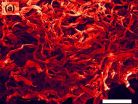(Press-News.org) ANN ARBOR--Research led by the University of Michigan Life Sciences Institute has identified a gene critical to controlling the body's ability to create blood cells and immune cells from blood-forming stem cells--known as hematopoietic stem cells.
The findings, scheduled for online publication in the Journal of Clinical Investigation April 13, provide new insights into the underlying mechanics of how the body creates and maintains a healthy blood supply and immune system, both in normal conditions and in situations of stress--like the body experiences following a bone marrow transplant.
Along with helping scientists better understand the body's basic processes, the discovery opens new lines of inquiry about the Ash1l gene's potential role in cancers known to involve other members of the same gene family, like leukemia, or those where Ash1l might be highly expressed or mutated.
"It's vital to understand how the basic, underlying mechanisms function in a healthy individual if we want to try to develop interventions for when things go wrong," said study senior author Ivan Maillard, an associate research professor at the Life Sciences Institute, where his lab is located, and an associate professor in the Division of Hematology-Oncology at the U-M Medical School.
"Leukemia is a cancer of the body's blood-forming tissues, so it's an obvious place that we plan to look at next. If we find that Ash1l plays a role, then that would open up avenues to try to block or slow down its activity pharmacologically," he said.
Graduate students Morgan Jones and Jennifer Chase were the study's first authors.
Dysfunction of blood-forming stem cells is well known in illnesses like leukemia and bone marrow failure disorders. Blood-forming stem cells can also be destroyed by high doses of chemotherapy and radiation used to treat cancer. The replacement of these cells through bone marrow transplantation is the only widely established therapy involving stem cells in human patients.
But even in the absence of disease, blood cells require constant replacement--most blood cells last anywhere from a few days to a few months, depending on their type.
Over more than five years, Maillard and his collaborators identified a previously unknown but fundamental role played by the Ash1l gene in regulating the maintenance and self-renewal potential of these hematopoietic stem cells.
The Ash1l (Absent, small or homeotic 1-like) gene is part of a family of genes that includes MLL1 (Mixed Lineage Leukemia 1), a gene that is frequently mutated in patients who develop leukemia. The research found that both genes contribute to blood renewal; mild defects were seen in mice missing one or the other, but lacking both led to catastrophic deficiencies.
"We now have clear evidence that these genes cooperate to develop a healthy blood system," Maillard said.
His lab's investigation of the gene began at the prompting of co-author Sally Camper, the James V. Neel Professor and Chair of the Department of Human Genetics in the U-M Medical School. Camper had been investigating Ash1l's role in endocrine and reproductive organs and saw clues that blood-forming tissues might also be affected.
The study found:
Ash1l-deficient mice had normal numbers of hematopoietic stem cells during early development, but a lack of stem cells in maturity--an indication the cells were not able to properly maintain themselves in the bone marrow.
Ash1l-deficient stem cells were unable to establish normal blood renewal after a bone marrow transplant. Moreover, Ash1l-deficient stem cells competed poorly with normal blood-forming stem cells in the bone marrow and could easily be dislodged.
Ash1l regulates the expression of multiple downstream "homeotic" genes, which help ensure the correct anatomical structure of a developing organism.
"This area of research really showcases the dynamic interplay between knowledge we can learn from human patients and discoveries undertaken in a laboratory setting," Maillard said.
After the U.S. dropped atomic bombs on Hiroshima and Nagasaki, doctors noticed that radiation patients weren't able to generate new white blood cells to fend off infections. Subsequent experiments on mice showed that bone marrow transplants from healthy animals into irradiated ones could renew their ability to make new blood cells. The technique was eventually developed for use in human patients, including those whose blood stem cells are killed off by cancer treatments. But work continues in the laboratory setting.
"By continuing to investigate the basic, underlying mechanisms--which builds on a history of research in fruit flies and in mice--we are helping to untangle the complex machinery of the blood renewal that may lay the foundation for new human treatments five, 10 or 20 years from now," Maillard said.
INFORMATION:
Additional authors: Michelle Brinkmeier, Department of Human Genetics; Daniel Weinberg, Julien Schira, Ann Friedman, Life Sciences Institute; Sami Malek, Division of Hematology-Oncology; Jing Xu, Jolanta Grembecka, Tomasz Cierpicki, Yali Dou, Department of Pathology.
Support for the research was provided by the Sidney Kimmel Cancer Research Foundation, the U-M Comprehensive Cancer Center, D. Dan and Betty Kahn Foundation, and the National Institutes of Health (RO1-AI091627, R37-HD30428). Individual support included T32 training grants from the U-M Medical Scientist Training Program, Center for Organogenesis, and Cellular and Molecular Biology Program.
The Life Sciences Institute is a nucleus of biomedical research at U-M. LSI scientists use a range of tools and model organisms to explore the most fundamental biological and chemical processes of life. The institute houses an academic early drug discovery center, a cryo-electron microscopy laboratory, a comprehensive protein production and crystallography facility, and a stem-cell biology center.
DALLAS, April 13, 2015--The American Heart Association (AHA) released new recommendations today to address gaps in common standards around comprehensive workplace wellness programs (CWWPs). The recommendations improve the design, measurement and recognition of CWWPs, and, if adopted by employers, could significantly impact efforts to improve the cardiovascular health of the American workforce.
An advisory panel of experts in population and workplace health, cardiology and preventive medicine conducted the review, which includes an extensive evaluation of workplace ...
WASHINGTON, DC - A medicinal liquid form of marijuana may show promise as a treatment for children with severe epilepsy that is not responding to other treatments, according to a study released today that will be presented at the American Academy of Neurology's 67th Annual Meeting in Washington, DC, April 18 to 25, 2015.
The study involved 213 people, ranging from toddlers to adults, with a median age of 11 who had severe epilepsy that did not respond to other treatments. Participants had Dravet syndrome and Lennox-Gastaut syndrome, epilepsy types that can lead to intellectual ...
Tropical Cyclone Solo was dissipating over the Southwestern Pacific Ocean when NASA's Aqua satellite passed overhead on April 13, 2015.
On April 11 Tropical Cyclone Solo spawned warnings in New Caledonia as it passed by. By April 12, the warnings were dropped and wind shear had taken its toll on the storm weakening it.
On April 12 at 0300 UTC (April 11 at 11 p.m. EDT), the Joint Typhoon Warning Center (JTWC) issued their final bulletin on Solo. At that time it was 116 nautical miles north of Noumea, New Caledonia near 20.2 south latitude and 165.7 east longitude. Solo ...
Skin is remarkably resistant to tearing and a team of researchers from the University of California, San Diego and the Lawrence Berkeley National Laboratory now have shown why.
Using powerful X-ray beams and electron microscopy, researchers made the first direct observations of the micro-scale mechanisms that allow skin to resist tearing. They identified four specific mechanisms in collagen, the main structural protein in skin tissue, that act together to diminish the effects of stress: rotation, straightening, stretching, and sliding. Researchers say they hope to replicate ...
TAMPA, Fla. - Moffitt Cancer Center researchers have developed a new method to identify a previously unknown structure in a protein called MDMX. MDMX is a crucial regulatory protein that controls p53 - one of the most commonly mutated genes in cancer.
Known as the tumor suppressor gene, p53 protects the body from cancer development by ensuring that DNA remains intact and does not have mutations. If p53 senses DNA damage, it can either stimulate the cells to repair its DNA, or cause cells to stop growing and undergo cell death. Because of its functions, p53 is often ...
ATLANTA--Chimpanzees are capable of some degree of planning for the future, in a manner similar to human children, while some species of monkeys struggle with this task, according to researchers at Georgia State University, Wofford College and Agnes Scott College.
Their findings were published on March 23 in the Journal of Comparative Psychology.
The study assessed the planning abilities of chimpanzees, two monkey species (rhesus macaques and capuchin monkeys) and human children (ages 28 to 66 months old) using a computerized game-like program that presented 100 unique ...
A workplace intervention designed to reduce work-family conflict gave employed parents more time with their children without reducing their work time.
"These findings may encourage changes in the structure of jobs and culture of work organizations to support families," said Kelly Davis, research assistant professor of human development and family studies.
The research is part of the Work, Family and Health Network's evaluation of the effects of a workplace intervention designed to reduce work-family conflict by increasing both employees' control over their schedule ...
(Boston) - Emergency departments (ED) provide a promising venue to address opioid deaths with education on both overdose prevention and appropriate actions in a witnessed overdose. In addition, ED's have the potential to equip patients with nasal naloxone rescue kits as part of this effort.
These findings are from a study published in the Western Journal of Emergency Medicine, and is the first study to demonstrate the feasibility of ED-based opioid overdose prevention education and naloxone distribution to trained laypersons, patients and their social network.
In ...
PROVIDENCE, R.I. [Brown University] -- Researchers from Brown University and the University of Rhode Island have demonstrated a promising new way to increase the effectiveness of radiation in killing cancer cells.
The approach involves gold nanoparticles tethered to acid-seeking compounds called pHLIPs. The pHLIPs (pH low-insertion peptides) home in on high acidity of malignant cells, delivering their nanoparticle passengers straight to the cells' doorsteps. The nanoparticles then act as tiny antennas, focusing the energy of radiation in the area directly around the cancer ...
CORVALLIS, Ore. - Researchers at Oregon State University have discovered how vitamin E deficiency may cause neurological damage by interrupting a supply line of specific nutrients and robbing the brain of the "building blocks" it needs to maintain neuronal health.
The findings - in work done with zebrafish - were just published in the Journal of Lipid Research. The work was supported by the National Institutes of Health.
The research showed that zebrafish fed a diet deficient in vitamin E throughout their life had about 30 percent lower levels of DHA-PC, which is a ...


